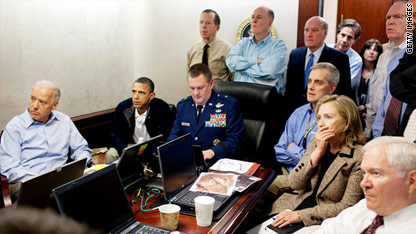Erasing Women from History
I think hardly anyone can have missed seeing that 'iconic' photograph from the White House Situation Room that was released last week. It's been dissected and deconstructed so many times that the discussion would fill millions of column inches. What was so significant to me about the photograph was the appearance of two people in particular:

On the right, near the front, Secretary of State Hillary Clinton. At the back, barely in the room, Audrey Tomason, Director of Counter-terrorism.
Twenty years ago, would there have been a single woman in the room? (Well, other than someone who was perhaps there to take notes). Certainly not during the Cold War. There are still shamefully few women in positions of influence around the world. But here, two women - who have arguably had to work even harder than most men to prove themselves and earn their status - are there, doing their jobs, proof that women have made it to the highest levels.
Well, not according to the version of history published by Di Tzeitung, a Hasidic (Orthodox Jewish) newspaper based in Brooklyn, New York.
They published a version of the same photo on Friday last week, but two people were missing. You've guessed it: Clinton and Tomason.
Why? Apparently, it is "religiously mandated" not to show photographs of women, according to the editor of the newspaper in an interview with CNN.
A reader posting a comment on the CNN page, who identifies (presumably) himself as a part of this Hasidic group, writes:
We have to understand the male and female attraction can be the most enticing draw that can have devastation consequences. Therefore our holy Torah has mandated that we provide ourselves with perimeter after perimeter, barrier after barrier of protection so that there should be no devastating consequences.
Was it so necessary to crop out the women in the ‘situation room” photo probably not but in order for us to give an objective opinion we must view this incident in the larger picture of self defense. defense of possible material that might slip through. If we work to understand that pictures of women that are foreign to us need not be viewed then that creates a strength on our part to be able to possibly withstand the temptation to look at more sensuous photos when they do come our way. But if the images of women are simply a part of the fabric of our every day cultural absorption then we have already lost the fight even before it began. We try to hardwire our mindset to deal with temptation even before it lurks in front of us.
2- Women, according to Judaism, share a special trait called binah, loosely translated as "deep understanding." In the Torah, women are exemplified as having a rich inner world, possessing a unique power to influence people's character; they are described as having insight and perception beyond logic, external facts and superficial facades.
If women are viewed externally, devoid of internal character and spirituality, they are stripped of their unique gift and strength. A danger exists that they will be objectified and degraded. In fact, we see that cultures which admire women primarily for their physical characteristics, ultimately degrade them and take advantage of them.
In view of this dangerous possibility - coupled with a strong tendency among males to notice the physical and external and be stimulated visually - women would do well to de-emphasize their bodies in order to emphasize that which is their real beauty: their inner strengths, their souls.
Regardless of any logic or otherwise in the above, there's one clear implication: women are 'other'. Men are the norm; women are abnormal and must hide themselves so men are not led into temptation. Earlier in the comment, the commenter - 'Jay' - likens encountering a photo of a woman to entering a military nuclear facility.
Yes, yes, we've heard all this before, time and time again. Yet again, classing women as 'other', blaming women for men's possible sexual offences, and again it's under the guise of religious freedom: this time orthodox Jewish, but it could just as easily be fundamentalist Christian or radical Islam.
Oh, the newspaper apologised and said they should not have printed the photograph - but not because of the offence to women. The White House, when it releases photographs, includes a disclaimer stating, among other things, that the photograph may not be manipulated in any way. And the newspaper's apology?
"Our photo editor realized the significance of this historic moment, and published the picture, but in his haste he did not read the 'fine print' that accompanied the picture, forbidding any changes," the newspaper said in its Monday statement.
So that's okay, then.


On the right, near the front, Secretary of State Hillary Clinton. At the back, barely in the room, Audrey Tomason, Director of Counter-terrorism.
Twenty years ago, would there have been a single woman in the room? (Well, other than someone who was perhaps there to take notes). Certainly not during the Cold War. There are still shamefully few women in positions of influence around the world. But here, two women - who have arguably had to work even harder than most men to prove themselves and earn their status - are there, doing their jobs, proof that women have made it to the highest levels.
Well, not according to the version of history published by Di Tzeitung, a Hasidic (Orthodox Jewish) newspaper based in Brooklyn, New York.
They published a version of the same photo on Friday last week, but two people were missing. You've guessed it: Clinton and Tomason.
Why? Apparently, it is "religiously mandated" not to show photographs of women, according to the editor of the newspaper in an interview with CNN.
A reader posting a comment on the CNN page, who identifies (presumably) himself as a part of this Hasidic group, writes:
We have to understand the male and female attraction can be the most enticing draw that can have devastation consequences. Therefore our holy Torah has mandated that we provide ourselves with perimeter after perimeter, barrier after barrier of protection so that there should be no devastating consequences.
Was it so necessary to crop out the women in the ‘situation room” photo probably not but in order for us to give an objective opinion we must view this incident in the larger picture of self defense. defense of possible material that might slip through. If we work to understand that pictures of women that are foreign to us need not be viewed then that creates a strength on our part to be able to possibly withstand the temptation to look at more sensuous photos when they do come our way. But if the images of women are simply a part of the fabric of our every day cultural absorption then we have already lost the fight even before it began. We try to hardwire our mindset to deal with temptation even before it lurks in front of us.
2- Women, according to Judaism, share a special trait called binah, loosely translated as "deep understanding." In the Torah, women are exemplified as having a rich inner world, possessing a unique power to influence people's character; they are described as having insight and perception beyond logic, external facts and superficial facades.
If women are viewed externally, devoid of internal character and spirituality, they are stripped of their unique gift and strength. A danger exists that they will be objectified and degraded. In fact, we see that cultures which admire women primarily for their physical characteristics, ultimately degrade them and take advantage of them.
In view of this dangerous possibility - coupled with a strong tendency among males to notice the physical and external and be stimulated visually - women would do well to de-emphasize their bodies in order to emphasize that which is their real beauty: their inner strengths, their souls.
Regardless of any logic or otherwise in the above, there's one clear implication: women are 'other'. Men are the norm; women are abnormal and must hide themselves so men are not led into temptation. Earlier in the comment, the commenter - 'Jay' - likens encountering a photo of a woman to entering a military nuclear facility.
Yes, yes, we've heard all this before, time and time again. Yet again, classing women as 'other', blaming women for men's possible sexual offences, and again it's under the guise of religious freedom: this time orthodox Jewish, but it could just as easily be fundamentalist Christian or radical Islam.
Oh, the newspaper apologised and said they should not have printed the photograph - but not because of the offence to women. The White House, when it releases photographs, includes a disclaimer stating, among other things, that the photograph may not be manipulated in any way. And the newspaper's apology?
"Our photo editor realized the significance of this historic moment, and published the picture, but in his haste he did not read the 'fine print' that accompanied the picture, forbidding any changes," the newspaper said in its Monday statement.
So that's okay, then.
